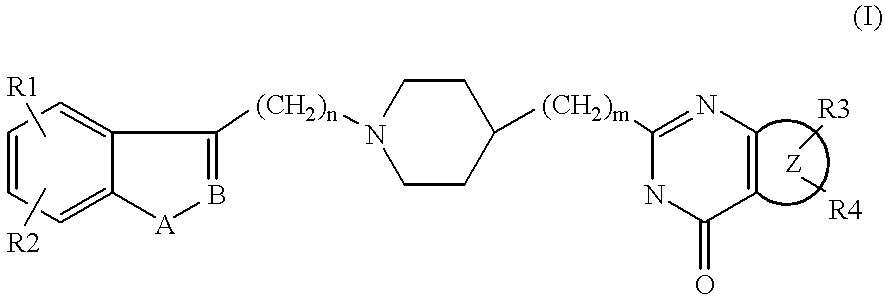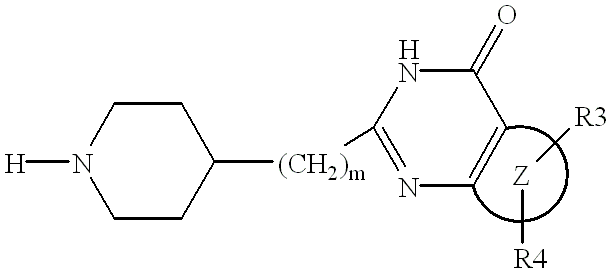Substituted 2-(4-piperidyl)-4(3H)-quinazolinones and 2-(4-piperidyl)-4(3H)-azaquinazolinones
a technology of azaquinazolinone and piperidyl, which is applied in the field of substituting 2(4piperidyl)4 (3h)quinazolinones and 2(4piperidyl)4 (3h)azaquinazolinones, which can solve the problems of limiting dosing and the potential to cause significant side effects
- Summary
- Abstract
- Description
- Claims
- Application Information
AI Technical Summary
Benefits of technology
Problems solved by technology
Method used
Image
Examples
example 1
4-(2-Carbamoyl-phenylcarbamoyl)-piperidine-1-carboxylic acid tert-butyl ester (3, R.sub.3, R.sub.4 =H, P=BOC, m=0, Z=benzene)
A solution of 2-aminobenzoic acid (about 2.7 g, 20 mmol), N-(tert-butoxycarbonyl) -4-piperidinecarboxylic acid (about 4.5 g, 20 mmol) and 1-[3-(dimethylamino)propyl]-3-ethylcarbodiimide hydrochloride (EDC) (about 3.8 g, 20 mmol) in pyridine (about 25 mL) was stirred at room temperature for 18 h. The mixture was diluted with water, extracted twice with ethyl acetate, and the combined ethyl acetate extract was washed with water, dilute aqueous HCl, and brine, dried (Na.sub.2 SO.sub.4) and evaporated in vacuo. The residue was crystallized from ether / hexane to afford compound 3 (R.sub.3 =H, P=BOC, m=0, Z=benzene) as a white solid (about 6.2 g, 91%); m.p. 153-154.degree. C.
example 2
2-[1-(tert-Butoxycarbonyl)-piperidin-4-yl]-3H-quinazolin-4-one (4, R.sub.3, R.sub.4 =H, P=BOC, m=0, Z=benzene)
A mixture of compound 3 (R.sub.3 R.sub.4 =H, P=BOC, m=0, Z=benzene) (about 3.5 g, 10 mmol) and potassium hydroxide (about 0.6 g, 10 mmol) in digylyme (20 mL) was stirred at 140.degree. C. for 1.5 h. The cooled mixture was diluted with water, cooled in an ice bath, and neutralized with HCl. The precipitate was collected by filtration and washed with water to afford compound 4 (R.sub.3, R.sub.4 =H, P=BOC, m=0, Z=benzene) (about 2.8 g, 85%) as a white solid; m.p. 225-227.degree. C.
example 3
2-(Piperidin-4-yl)-3H-quinazolin-4-one (5, R.sub.3 =H, m=0, Z=benzene)
Compound 4 (R.sub.3 R.sub.4 =H, P=BOC, m=0, Z=benzene) (about 3.3 g, 10 mmol) was suspended in dichloromethane (10 mL) and trifluoroacetic acid (10 mL) was added. The resulting solution was stirred at room temperature for 30 min and then concentrated in vacuo. The residue was dissolved in water and solution was neutralized with ammonium hydroxide. The precipitate was filtered, washed with water and dried to afford the title compound as a white solid (about 2.1 g, 92%); m.p. 244-245.degree. C.
The following were similarly prepared:
5-chloro-2-(piperidin-4-yl)-3H-quinazolin-4-one (5, R.sub.3 =5-Cl, R.sub.4 =H, m=0, Z=benzene); m.p. 259-260 C;
6-chloro-2-(piperidin-4-yl)-3H-quinazolin-4-one (5, R.sub.3 =6-Cl, R.sub.4 =H, m=0, Z=benzene); m.p. 253-255 C;
7-chloro-2-(piperidin-4-yl)-3H-quinazolin-4-one (5, R.sub.3 =7-Cl, R.sub.4 =H, m=0, Z=benzene); m.p. 248-249 C;
5-fluoro-2-(piperidin-4-yl)-3H-quinazolin-4-one (5, R.sub.3...
PUM
 Login to View More
Login to View More Abstract
Description
Claims
Application Information
 Login to View More
Login to View More - R&D
- Intellectual Property
- Life Sciences
- Materials
- Tech Scout
- Unparalleled Data Quality
- Higher Quality Content
- 60% Fewer Hallucinations
Browse by: Latest US Patents, China's latest patents, Technical Efficacy Thesaurus, Application Domain, Technology Topic, Popular Technical Reports.
© 2025 PatSnap. All rights reserved.Legal|Privacy policy|Modern Slavery Act Transparency Statement|Sitemap|About US| Contact US: help@patsnap.com



